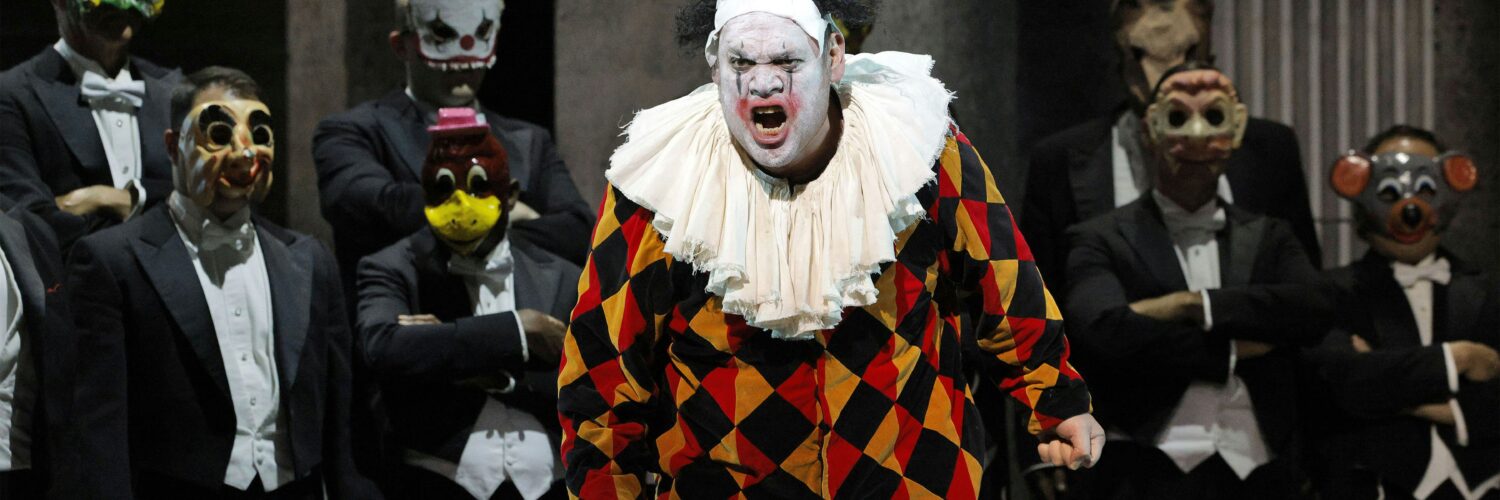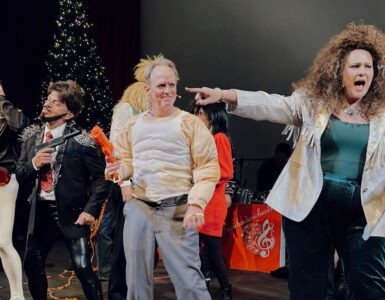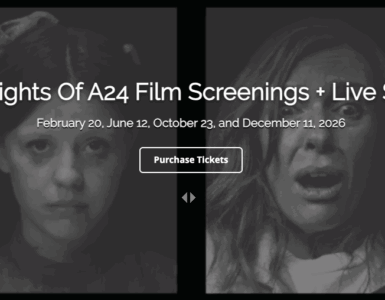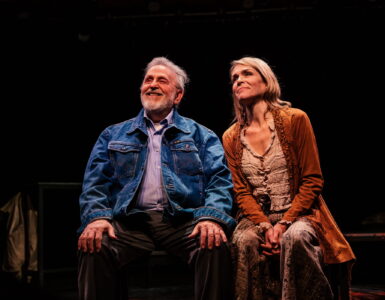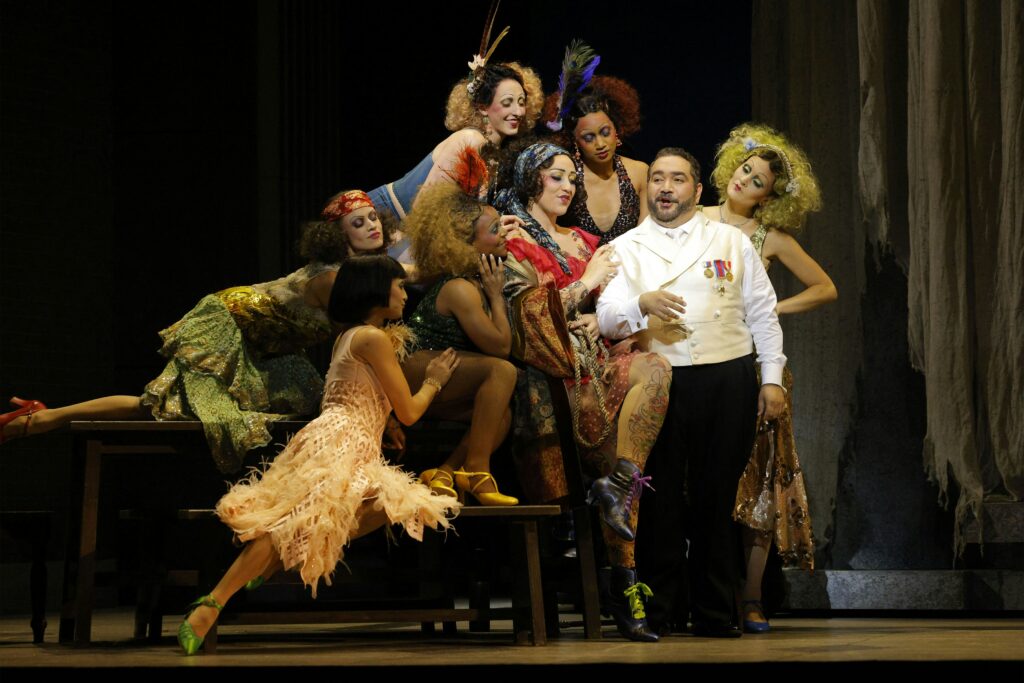 Sinister, menacing and timely—LA Opera’s 2025 revival of Rigoletto reconceives Verdi’s 1851 tragedy with a dark, noir aesthetic that feels both politically charged and emotionally potent. Conceived as a fever dream of fascist decadence and tragic power, the heartbreaking opera gains more relevance than ever with this reimagined staging.
Sinister, menacing and timely—LA Opera’s 2025 revival of Rigoletto reconceives Verdi’s 1851 tragedy with a dark, noir aesthetic that feels both politically charged and emotionally potent. Conceived as a fever dream of fascist decadence and tragic power, the heartbreaking opera gains more relevance than ever with this reimagined staging.
Above photo: René Barbera as the Duke of Mantua (with Sarah Saturnino as Maddalena, in red dress and blue patterned headband) in LA Opera’s 2025 production of Rigoletto. (Photo: Cory Weaver)
Tickets are still available for the final performance of this magnificent production of Rigoletto, on Saturday June 21, starting at 7.30PM. The performance is 2 hours and 30 minutes, with a 25-minute intermission.
By updating the setting to fascist-era Italy, director Tomer Zvulun has made a deliberate choice to reinterpret the opera’s original setting of the mid-19th century and relocate it to Mussolini’s Italy of the 1920s. This shrewd staging concept brings a chilling relevance, reinforcing themes of power, corruption, and anonymity—especially through the frequent use of creepy masks, imposing scenic design and stark lighting. The result is a beautiful yet dark production that’s brimming with dramatic intensity, modern staging, and stellar vocal performances. Above all, this production succeeds in amplifying the opera’s moral and psychological depth.
The story begins at a debauched party being held at an authoritarian court, with lavishly dressed partygirls, jugglers and street performers on hand to amuse the mostly male guests – besuited, masked and predatory. Zvulun imagines the Duke’s court not in Renaissance Mantua, but as a corrupt Fascist enclave teeming with masked sycophants and racy flappers. A rotating monolith set—sleek, monumental, and ever-shifting—transports us seamlessly from opulent ballrooms to dim alleyways and Gilda’s cloistered chamber. Scenic design is by Erhard Rom, whose minimalist yet haunting set creates versatile spaces. From the fascist-era court to Gilda’s secluded balcony—it all supports and empowers Zvulun’s stark visual narrative and amplifies the opera’s moody, authoritarian atmosphere. The visuals echo Fellini’s decadent surrealism and Buñuel’s dread. Reminiscent of The Purge movie series, the chorus are masked in grotesque anonymity, and represent a chilling symbol of mob cruelty. Costume design is by Jessica Jahn.
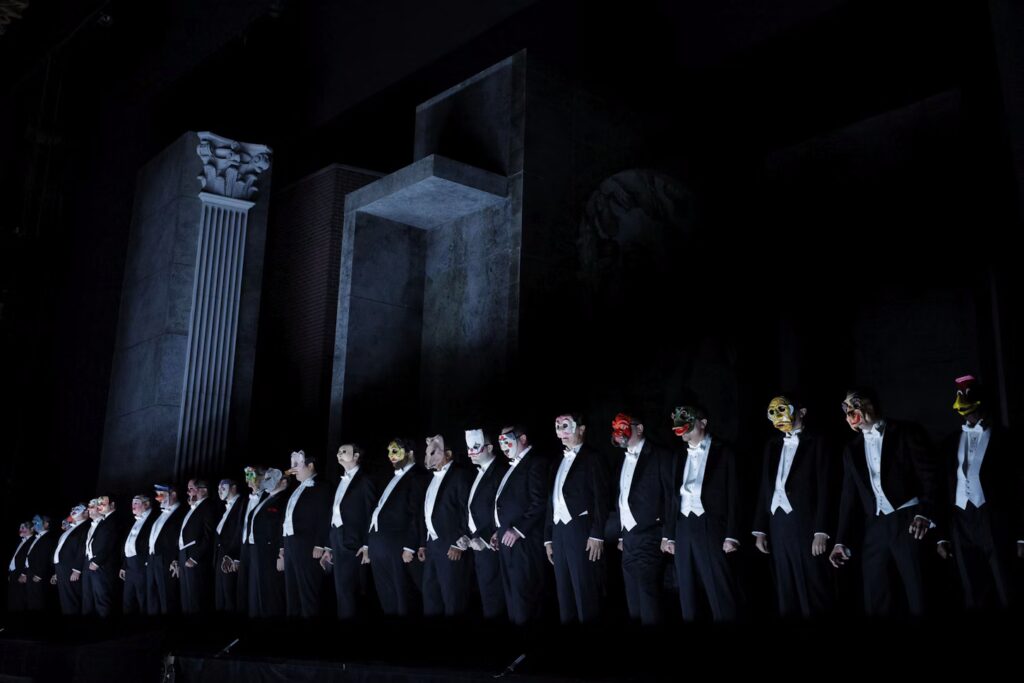
At the center of the production is baritone Quinn Kelsey in the title role, earning nearly universal praise for his portrayal of the tormented court jester. Kelsey’s Rigoletto is both monstrous and heartbreakingly human. Dressed in a blood-red, harlequin printed clown suit, his ghastly makeup evoking spooky killer clowns such as John Wayne Gacy and Stephen King’s Pennywise, Kelsey elicits both ridicule and pity, moving with a tortured physicality and delivering his arias with searing emotional force. His “Cortigiani, vil razza dannata” becomes less a cry for justice and more a howl of existential despair. His rendition of “Pari siamo” and the final scenes were particularly nuanced and powerful, drawing us deeply into Rigoletto’s anguish.
Soprano Lisette Oropesa (alternating with Kathryn Lewek) sings Gilda with angelic clarity, capturing the character’s naive devotion and ultimate tragic strength. Her performance evolved from innocence to maturity in a manner that felt authentic and moving. The chemistry between Oropesa and Kelsey added a compelling emotional layer to the production, making Gilda’s fate all the more tragic. Her famous aria “Caro nome” was angelic and emotionally resonant, with a purity in tone that was haunting. Her performance sparkled with innocence, making her sacrifice during the lightning and thunderstorm-lashed finale all the more devastating.
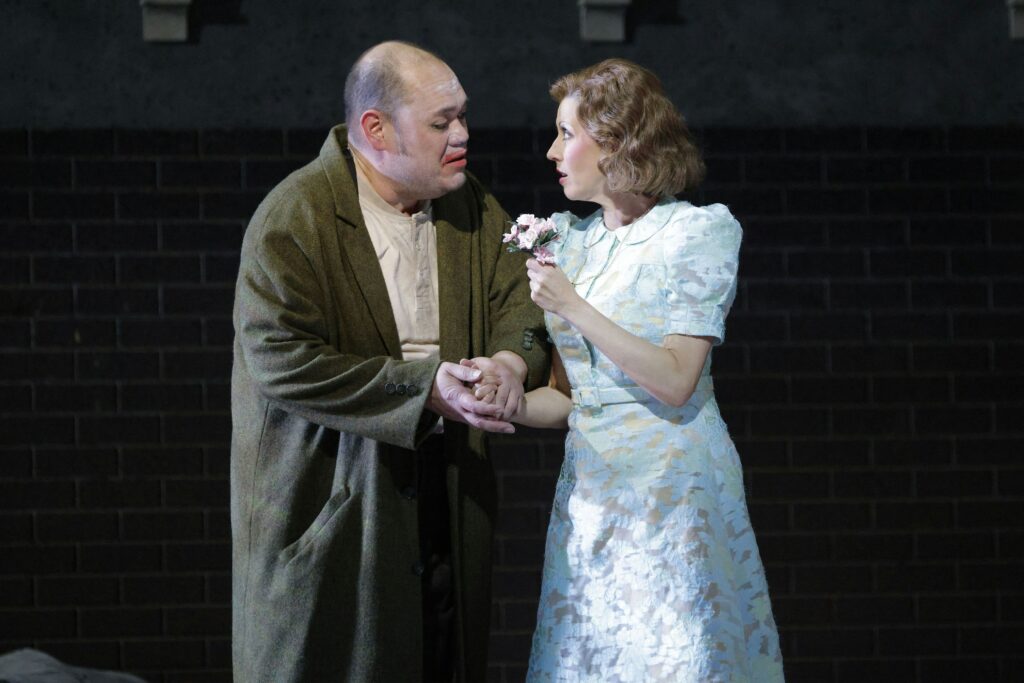
Tenor René Barbera, as the libertine Duke of Mantua, offered a charismatic and vocally agile interpretation. Here was a confident and chilling predator cloaked in unctuous allure. His “La donna è mobile” was delivered with both charm and cruelty, thus presenting a Duke who was equally seductive and dangerous. His sinister performance contributed to the overall tension and momentum of the opera.
James Conlon, a long-standing musical pillar at LA Opera, was anchored the production musically and was in fine form. The orchestra, under Conlon’s baton, delivered Verdi’s score with thrilling dynamism—brass lines exploded like gunfire, and string phrases shimmered with tension. The music and visuals often seemed to breathe as one, especially during the climactic storm scene, where strobe lighting and sonic crescendos plunged the audience into a state of operatic vertigo.
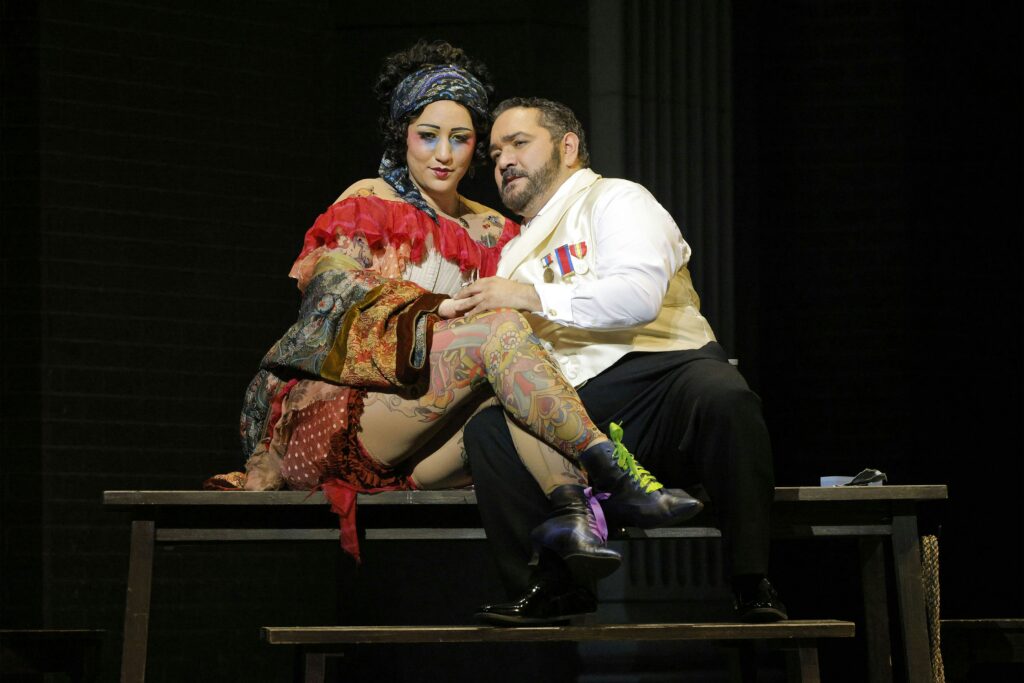
The opera’s background:
When Verdi’s Rigoletto premiered in 1851, it didn’t just push boundaries—it detonated them. Over 170 years later, the opera still feels unsettling, fresh, and tragically human. Watching LA Opera’s current production, one is reminded why Rigoletto remains one of the most groundbreaking works in the operatic canon.
At its heart is a brutal paradox: a jester who becomes the ultimate victim of the cruelty he once served. Rigoletto isn’t a nobleman or a mythic figure—he’s a working-class man, bitter and deformed, clinging to love as his last shred of dignity. The emotional range Verdi gives this character is astonishing, and in the hands of today’s finest baritones, his journey is nothing short of devastating. The same can be said of Gilda, his daughter, whose innocence is not just lost but weaponized in a world where power and predation are inseparable.
Musically, Rigoletto is a triumph of integration. The opera’s iconic moments—like the sardonic charm of “La donna è mobile” or the intricate quartet “Bella figlia dell’amore”—aren’t stand-alone arias to be admired from a distance. They are engines of character development, revealing the conflicting desires and deceptions at play. Even the use of recurring musical ideas, especially the “curse” motif, adds a chilling dramatic coherence that was well ahead of its time.
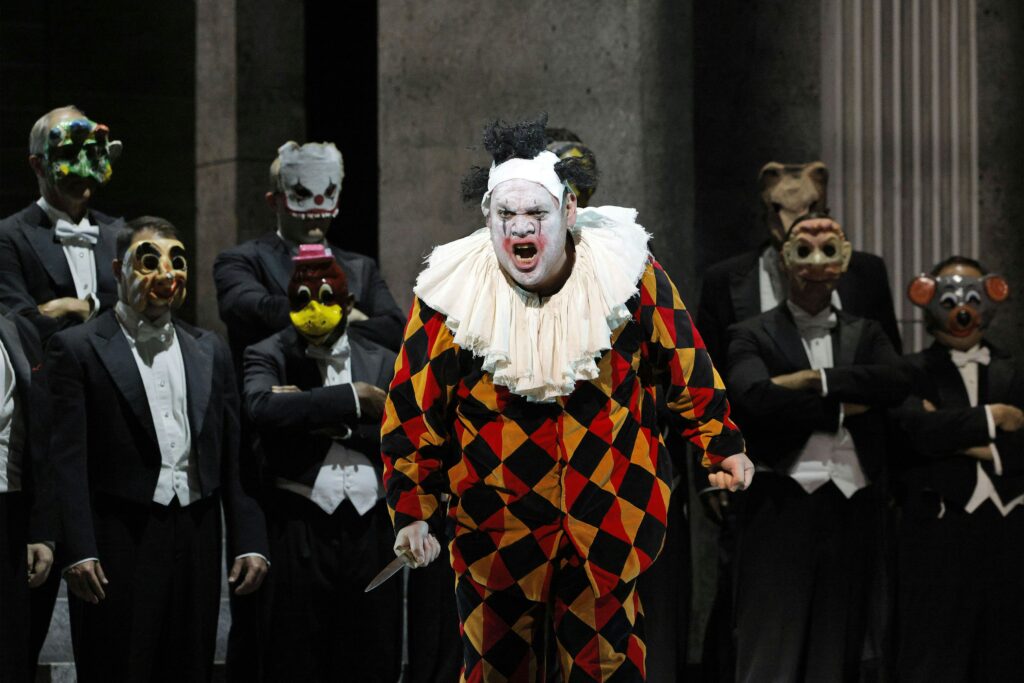
Verdi also used Rigoletto to challenge both the audience and the authorities. Based on Victor Hugo’s banned play Le roi s’amuse, the opera faced fierce censorship before its debut in Venice. Verdi fought to retain its essence, creating a story that dared to portray the ruling class as venal, exploitative, and morally bankrupt. In this way, he gave opera a political voice and paved the way for realism and social critique on the operatic stage.
What makes Rigoletto endure, however, isn’t just its innovation but its relevance. The opera’s themes of abuse of power, toxic masculinity, blind revenge, and the fragility of love are as resonant today as they were in the 19th century. There is no true hero in Rigoletto; instead, Verdi gives us a world full of contradictions, where nobility and cruelty coexist, and where tragedy feels terrifyingly inevitable.
In the right hands, Rigoletto doesn’t feel like a museum piece, it feels like a warning. LA Opera’s current staging embraces that darkness and delivers it unflinchingly. It’s not comfortable, and it’s not supposed to be.
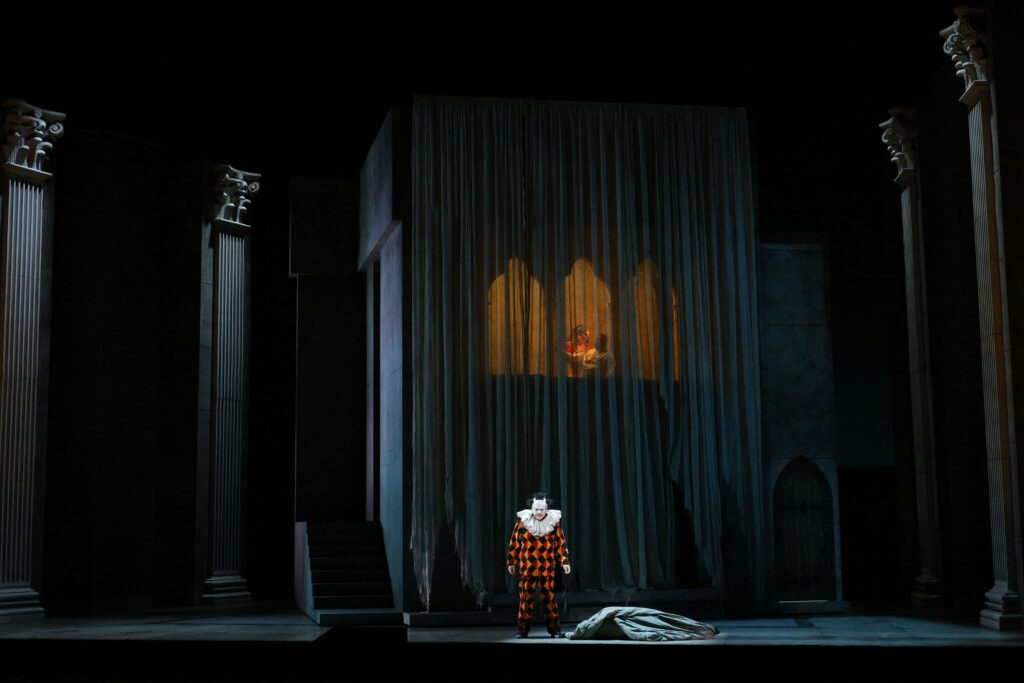
Tickets are still available for the final performance of LA Opera’s 2025 magnificent production of Rigoletto, Saturday June 21, starting at 7.30PM. The performance is 2 hours and 30 minutes, with a 25-minute intermission.
LA Opera performs in the Dorothy Chandler Pavilion, at the Music Center in downtown LA.
135 North Grand Avenue, Los Angeles, 90012
For additional details, visit LAOpera.org.


